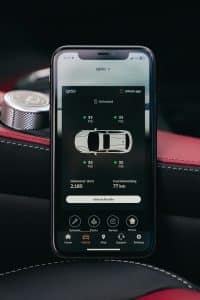
If you’ve purchased a new vehicle in the past few years, you’ve probably been encouraged to download the manufacturer’s companion app. These apps—FordPass, myChevrolet, Hyundai Bluelink, BMW ConnectedDrive, Tesla, and many others—offer convenient features like remote start, lock/unlock, vehicle health reports, and EV charging tools. But behind that convenience is a surprising amount of data quietly stored, transmitted, and analyzed.
As my friend aptly put it: “the app that came with my new truck tells everything about how its driven, right down to whether the operator had an unclean thought.”
Understanding this data matters for privacy, safety, and, in some situations, helping reconstruct what happened before or after a collision.
Your Vehicle’s Digital Health Report
Most car apps pull real-time diagnostic data from the vehicle’s onboard computers. This typically includes:
- Odometer readings
- Fuel level or EV battery state of charge
- Tire pressure
- Oil life and maintenance indicators
- Check-engine codes and system warnings
Manufacturers use this information to provide alerts and schedule maintenance, but it also means your vehicle’s condition over time is logged on company servers. After an accident, this sort of information can sometimes help clarify whether a mechanical issue was building up before the event or how the vehicle’s systems were functioning.

Location Tracking and Trip History
One of the most significant types of data these apps collect is location. Many record:
- Real-time GPS location
- Driving routes, including start and stop points
- Trip lengths and timestamps
- Last-parked location
Some apps also log driving behaviors, such as speeding, harsh braking, or sudden acceleration. These features are often marketed as tools for safe-driving feedback or teen-driver monitoring, but they can paint a very detailed picture of how a vehicle was being used over days, weeks, or even months.
Take the FordPass for example. After a good amount of searching on their website, I was able to find Ford’s privacy policy which states that “Connected Vehicle Information” may be sent directly to Ford from your vehicle (depending on the settings). “Connected Vehicle Information” includes:
- Information about your vehicle, its components and parts, including their status and performance and diagnostics of vehicle systems (eg. VIN, hardware model and part numbers, odometer, tire pressure, fuel and fluid levels, battery and lock status, trouble codes, warning indicators and alerts);
- Driving characteristics and behaviour, including information about how the vehicle is operated and used (eg. speed, use of accelerator, brakes, steering and seat belts);
- In-vehicle services information about the performance and use of vehicle services, systems and technology, such as navigation and infotainment systems (eg. WiFi and mobile network connection, hardware and software information such as version numbers, seat positions, phone/blue tooth pairings, climate controls, connectivity settings);
- Precise GPS location information about your vehicle, including its current location (latitude and longitude in real time), travel direction and speed;
- Connection status alerts sent by the modem to stay connected to the network consisting of VIN, SIM and electronic serial number of the modem; and
- Over the air update information such as version of FordPass Connect (SYNC Connect) or Lincoln Connect and other technical specifications associated with a specific modem
What You Can Control
Most vehicle apps allow some degree of privacy customization. You can often disable trip history, limit location tracking, turn off certain connected services, or restrict data sharing with third parties. These settings aren’t always obvious, so it’s worth reviewing your app’s privacy menu when you first set it up.
Why This Information Matters
Vehicles today are more connected than ever, and the data they gather can provide a remarkably detailed picture of how they were driven and what happened in the moments leading up to an accident.
Motor vehicle accident lawyers need to be attune to this new reality. Whether it is your own clients connected vehicle information or that of another driver, this should be captured and preserved as soon as possible following an accident wherever there’s a real question as to who is at fault.

















